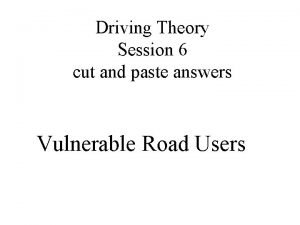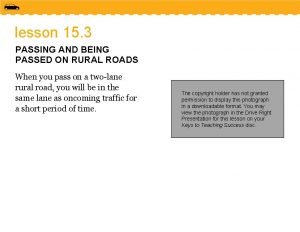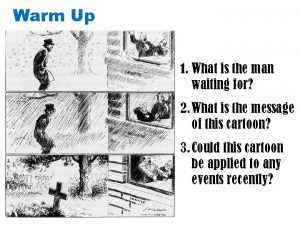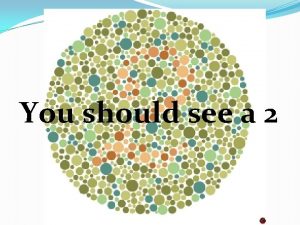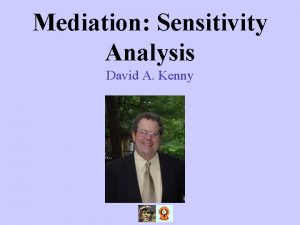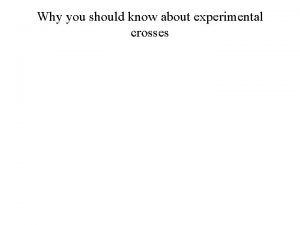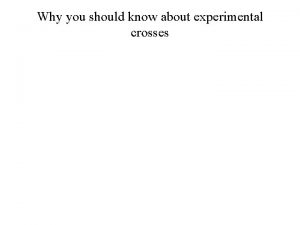SENSITIVITY Outline What is Sensitivity Why Should You




















- Slides: 20

SENSITIVITY Outline What is Sensitivity & Why Should You Care? What Are Measures of Antenna Performance? What is the Sensitivity of an Interferometer? What is the Sensitivity of a Synthesis Image? Summary J. M. Wrobel - 19 June 2002 SENSITIVITY 1

What is Sensitivity & Why Should You Care? • Measure of weakest detectable radio emission • Important throughout research program – Technically sound observing proposal – Sensible error analysis in publication • Expressed in units involving Janskys • – Unit for interferometer is Jansky (Jy) – Unit for synthesis image is Jy beam-1 1 Jy = 10 -26 W m-2 Hz-1 = 10 -23 erg s-1 cm-2 Hz-1 • Common to use milli. Jy or micro. Jy J. M. Wrobel - 19 June 2002 SENSITIVITY 2

Measures of Antenna Performance Source and System Temperatures • What is received power P? • Write P as equivalent temperature of matched termination at receiver input – – – • • Rayleigh-Jeans limit to Planck law Boltzmann constant k. B Observing bandwidth Amplify P by g 2 where g is voltage gain Separate powers from source, system noise – – Source antenna temperature Ta => source power System temperature Tsys => noise power J. M. Wrobel - 19 June 2002 SENSITIVITY 3

Measures of Antenna Performance Gain • Source power – Let – Then • for source flux density S, constant K (1) But source power also (2) – Antenna area A, efficiency – Receiver accepts 1/2 radiation from unpolarized source • Equate (1), (2) and solve for K – K is antenna’s gain or “sensitivity”, unit degree Jy-1 • K measures antenna performance but no Tsys J. M. Wrobel - 19 June 2002 SENSITIVITY 4

Measures of Antenna Performance System Equivalent Flux Density • Antenna temperature – Source power • Express system temperature analogously – Let – SEFD is system equivalent flux density, unit Jy – System noise power • SEFD measures overall antenna performance – Depends on Tsys and – Examples in Table 9 -1 J. M. Wrobel - 19 June 2002 SENSITIVITY 5

Interferometer Sensitivity Real Correlator - 1 • Simple correlator with single real output that is product of voltages from antennas j, i – SEFDi = Tsysi / Ki and SEFDj = Tsysj / Kj – Each antenna collects bandwidth • Interferometer built from these antennas has – Accumulation time , system efficiency – Source, system noise powers imply sensitivity • Weak source limit – S << SEFDi – S << SEFDj J. M. Wrobel - 19 June 2002 SENSITIVITY 6

Interferometer Sensitivity Real Correlator - 2 • For SEFDi = SEFDj = SEFD drop subscripts – Units Jy • Interferometer system efficiency – Accounts for electronics, digital losses – Eg: VLA continuum • • Digitize in 3 levels, collect data 96. 2% of time Effective J. M. Wrobel - 19 June 2002 SENSITIVITY 7

Interferometer Sensitivity Complex Correlator • Delivers two channels – Real SR , sensitivity – Imaginary SI , sensitivity • Eg: VLBA continuum – Figure 9 -1 at 8. 4 GHz – Observed scatter SR(t), SI(t) – Predicted = 69 milli. Jy – Resembles observed scatter J. M. Wrobel - 19 June 2002 SENSITIVITY 8

Interferometer Sensitivity Measured Amplitude • Measured visibility amplitude – Standard deviation (sd) of SR or SI is • • True visibility amplitude S Probability – Figure 9 -2 – Behavior with true S / • • • High: Gaussian, sd Zero: Rayleigh, sd Low: Rice. Sm gives biased estimate of S. Use unbias method. J. M. Wrobel - 19 June 2002 SENSITIVITY 9

Interferometer Sensitivity Measured Phase • Measured visibility phase • • True visibility phase Probability – Figure 9 -2 – Behavior with true S / • • • High: Gaussian Zero: Uniform Seek weak detection in phase, not amplitude J. M. Wrobel - 19 June 2002 SENSITIVITY 10

Image Sensitivity Single Polarization • Simplest weighting case where visibility samples – Have same interferometer sensitivities – Have same signal-to-noise ratios w – Combined with natural weight (W=1), no taper (T=1) • Image sensitivity is sd of mean of L samples, each with sd , ie, – No. of interferometers – No. of accumulation times – So J. M. Wrobel - 19 June 2002 SENSITIVITY 11

Image Sensitivity Dual Polarizations - 1 • Single-polarization image sensitivity • Dual-polarization data => image Stokes I, Q, U, V – Gaussian noise in each image – Mean zero, • Polarized flux density – Rayleigh noise, sd – Cf. visibility amplitude, Figure 9 -2 • Polarization position angle – Uniform noise between – Cf. visibility phase, Figure 9 -2, J. M. Wrobel - 19 June 2002 SENSITIVITY 12

Image Sensitivity Dual Polarizations – 2 • Eg: VLBA continuum – Figure 9 -3 at 8. 4 GHz – Observed • • T: Stokes I, simplest weighting B: Gaussian noise = 90 micro. Jy beam-1 – Predicted • • • Previous eg Plus here L = 77, 200 So = 88 micro. Jy beam-1 J. M. Wrobel - 19 June 2002 SENSITIVITY 13

Image Sensitivity Dual Polarizations – 3 • Eg: VLBA continuum – Figure 9 -3 at 8. 4 GHz – Observed • • T: Ipeak = 2 milli. Jy beam-1 B: Gaussian noise = 90 micro. Jy beam-1 – Position error from sensitivity? • • • Gaussian beam = 1. 5 milliarcsec Then = 34 microarcsec Other position errors dominate J. M. Wrobel - 19 June 2002 SENSITIVITY 14

Image Sensitivity Dual Polarizations – 4 • Eg: VLA continuum – Figure 9 -4 at 1. 4 GHz – Observed • • Q, U images, simplest weighting Gaussian = 17 micro. Jy beam-1 – Predicted • = 16 micro. Jy beam-1 J. M. Wrobel - 19 June 2002 SENSITIVITY 15

Image Sensitivity Dual Polarizations – 5 • Eg: VLA continuum – Figure 9 -4 at 1. 4 GHz – Observed • • • Q, U images, simplest weighting = 17 micro. Jy beam-1 Form image of Rayleigh noise in P Sd 11 micro. Jy beam-1 – Predicted • • Sd Sd 11 micro. Jy beam-1 J. M. Wrobel - 19 June 2002 SENSITIVITY 16

Image Sensitivity Dual Polarizations – 6 • Eg: VLA continuum – Figure 9 -4 at 1. 4 GHz – Observed • • I, Q, U images, simplest weighting Gaussian noise – I, Q, U will have same sd if each is limited by sensitivity • • Recall Other factors can increase Suspect dynamic range as Ipeak = 10, 000 Lesson: Use sensitivity as tool to diagnose problems J. M. Wrobel - 19 June 2002 SENSITIVITY 17

Sensitivity Summary – 1 • One antenna – System temperature Tsys – Gain K • Overall antenna performance is measured by system equivalent flux density SEFD – Units Jy J. M. Wrobel - 19 June 2002 SENSITIVITY 18

Sensitivity Summary - 2 • Connect two antennas to form interferometer – Antennas have same SEFD, observing bandwidth – Interferometer system efficiency – Interferometer accumulation time • Sensitivity of interferometer – Units Jy J. M. Wrobel - 19 June 2002 SENSITIVITY 19

Sensitivity Summary - 3 • Connect N antennas to form array – – • Antennas have same SEFD, observing bandwidth Array has system efficiency Array integrates for time tint Form synthesis image of single polarization Sensitivity of synthesis image – Units Jy beam-1 J. M. Wrobel - 19 June 2002 SENSITIVITY 20
 Hey bye bye
Hey bye bye Wh tongue twister
Wh tongue twister What should you do when passing sheep on a road
What should you do when passing sheep on a road Dont ask why why why
Dont ask why why why What are the three stages of passing?
What are the three stages of passing? Velocitation means
Velocitation means Chapter 24 review questions milady
Chapter 24 review questions milady What is sentence outline
What is sentence outline 5 paragraph essay outline
5 paragraph essay outline Subpoints in a preparation outline are
Subpoints in a preparation outline are If i could only teach you one thing
If i could only teach you one thing If you could be invisible what would you do and why?
If you could be invisible what would you do and why? Outline why
Outline why Why should i feel discouraged
Why should i feel discouraged Why school should be shorter
Why school should be shorter Chapter 11 managing weight and eating behaviors
Chapter 11 managing weight and eating behaviors Lorenzo neal wrestling
Lorenzo neal wrestling Why all businesses should embrace sustainability
Why all businesses should embrace sustainability Why christians should not celebrate halloween
Why christians should not celebrate halloween What is this
What is this Sda hymnal 515
Sda hymnal 515


